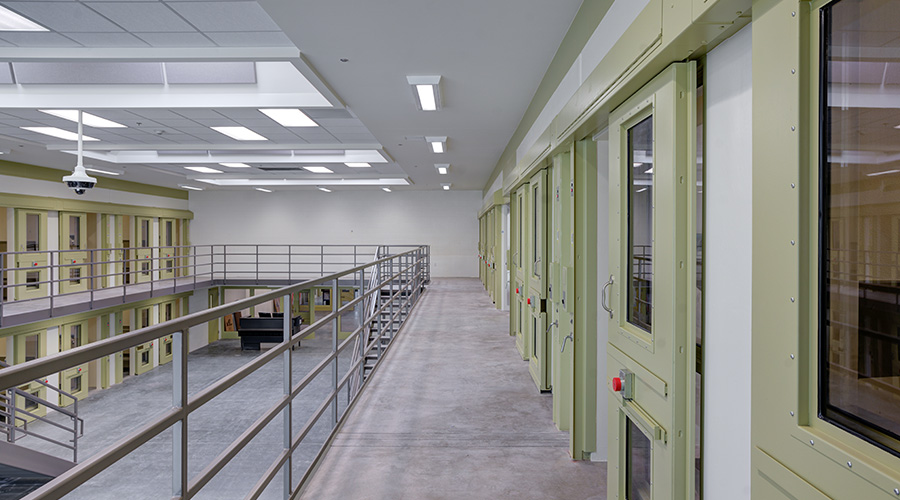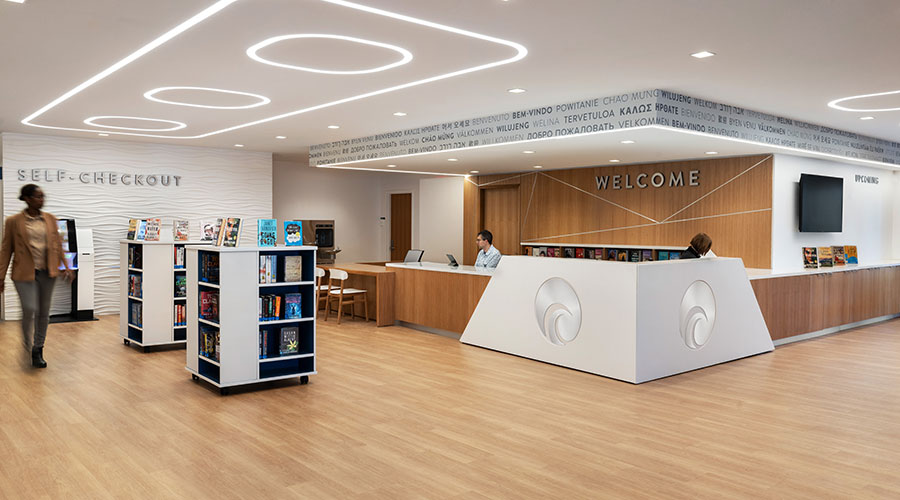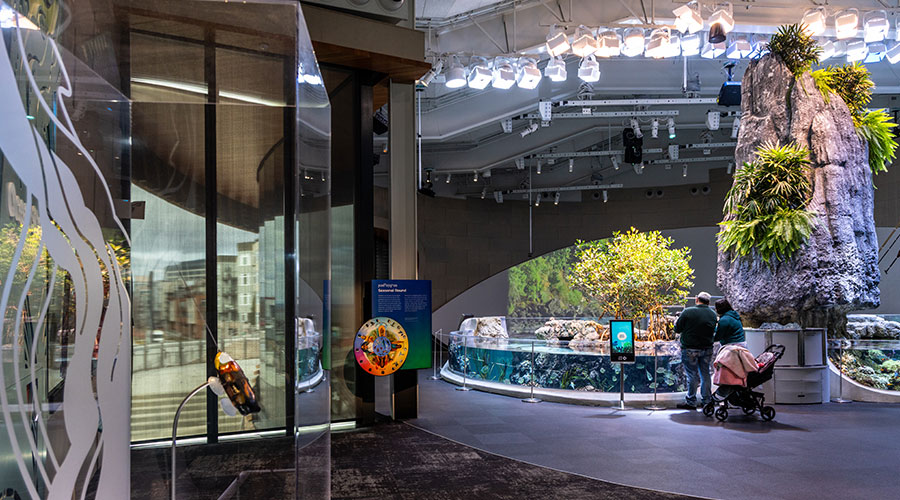Lighting Controls: A New Generation
Rapidly advancing technology and evolving occupant demands create complex challenges for owners planning lighting controls upgrades.
By Dan Hounsell, Senior Editor
These are not the last generation’s lighting controls. They are not even last year’s lighting controls in many cases. Technology has responded rapidly in recent years to growing demands from building owners for more control over lighting in institutional and commercial facilities, as well as evolving expectations from users looking for more appealing and healthier workspaces.
“There’s a trend toward human-centric buildings, so the tenant or whoever is in a space feels more comfortable,” says Allyson Evans, senior lighting designer with Henderson Engineers. “Daylighting plays a huge part in that. Lighting controls can control the electric lighting depending on the daylight in the space to make humans feel better. They enjoy daylight. So if there’s a lot of daylight in a space, we can reduce the electric light levels to reduce energy cost but also to create a space that’s happy and bright using daylight instead of electric light.”
To achieve these and other goals related to lighting in facilities, building owners and facility executives considering lighting controls upgrades need to understand their facilities’ needs, changing technology options and the importance of addressing post-installation issues.
Determining needs
Given the number of parties involved in planning a lighting controls upgrade, the cost of the project and the impact it can have on facilities and an organization’s bottom line, the process can seem as complex as the technology involved.
“When (owners) first start thinking about lighting controls and what they are going to need for their facility, code compliance is definitely number one,” Evans says. “Will the lighting control system meet the local and national energy codes for their location? It depends on the building type. An office or a hospital is going to have a different standard than a parking garage. Knowing those limitations to meet your code compliance is priority.”
Bill Trivett, senior vertical engineering director with JLL, points out several additional considerations for owners assessing facility lighting needs.
“It’s important for us to know about the electrical that’s sitting there currently,” Trivett says. “For us, we need to know, ‘Are we going to be staying with a line voltage, or are we going to with low-voltage lighting replacements? What does the floor plan look like?’
“When you’re actually looking at your building, how in depth are you going to go? Are you going to be changing out your entire ceiling plan? Are you going to be looking at removing the ceiling grids?”
Perhaps the broadest challenge facing owners planning lighting controls upgrades is understanding their own goals for the facility.
“What do they want this building to do and over what time period?” Trivett asks. “Lighting controls have come so far over the past several years. You can control light fixtures down to each individual luminaire, or you can create control whole zones. It’s a matter of what the owner wants to do with their lighting control system to maintain their building.”
Trivett points to two sources of information that can help managers determine the scope and goals of a lighting system upgrade. The first is the in-house facilities team.
“It’s really important for us to sit down with the building engineering staff and get that granular to find out what their challenges are,” he says. “Why are they going out to replace lights in the first place? If it’s energy and sustainability, fine. Or is it better maintenance? Those are some of the key points that all of us need to go back to.”
Trivett also recommends performing a photometric computer simulation of the space in question to determine the way light leaves fixtures and enters surrounding areas to provide key data on light fixtures and lighting design.
“Without a photometric, you don’t know where you’re at, and you don’t know where you need to be,” he says. “A lot of building owners do not understand what a photometric is, and they don’t understand the importance of it. We need to put things in layman’s terms and actually help build them the case.”
Technology and products
Lighting controls technology has made major advances in recent years, with wireless technology among the potentially most impactful advance.
“For certain facilities in certain spaces, (wireless technology) offers a lot of flexibility for future growth because you don’t have to rewire new devices,” Evans says. “If (owners) add more offices or change an office into a conference room and lighting control needs change, wireless controls can offer a very quick and easy solution and fix to a space change.”
Wireless controls technology can help owners and designers address growing expectations for control systems related to the wellbeing of facility occupants and staff, in addition to the need for energy-efficient lighting. Evans points to the impact of the technology on interior spaces that are traditionally poorly lit, such as locker rooms.
“It’s not necessarily daylight control but tuning the white color in a space that has no windows with a daylight sensor on the exterior of the building,” she says. “The light fixtures in a windowless space can synchronize with the color of the sun. In NFL and collegiate locker rooms and lounges, it helps the performance and balances circadian rhythms and enhances performance.”
For owners looking into technology and products for lighting system upgrades, Trivett says a product’s warranty should be among the top priorities because the warranty is likely to indicate the quality of the product.
A strong warranty “means that a company’s going to stand behind it,” he says. “The company’s going to stand behind providing you their best product. So I always start off with, ‘What is your warranty? And what is your response time on getting me parts for that piece of equipment when it does go down?’
“Is it something that I can go ahead and have my site team perform the work, or do I need to bring your team in to reprogram? How efficient is it for the site team to mitigate the challenges to reinstall the equipment? It’s important for us to understand there are some companies out there that are standing behind their product very well.”
Beyond installation
While the decisions building owners make on issues related to facility needs and product selection are important, their decisions about the project’s post-installation phase are just as likely to determine the project’s ultimate success or failure. One such decision involves tapping into the knowledge of the facilities team during project planning.
“Within a building itself, the maintenance and facilities groups are really the first ones that come and talk to us and explain what they want and what they want to maintain and what they don’t want to maintain,” Evans says. “Make sure that lighting controls equipment is placed in an area that’s easy to maintain. That is usually something that we focus on first so if something happens to go wrong, the facilities group can easily get in there and fix the issue.”
Facilities teams also will need to be able to make changes to the upgraded control system, given the many potential changes in space usage that owners must plan for. For that reason, a flexible system is essential.
“The complexity of programming also tends to be a sticking point at times after the building is occupied,” Evans says. “If they need to make changes to programming, to know that there is a lighting controls manufacturer nearby that can come and do on-site training and is easy to contact via the phone and can make site visits. Selecting the correct reputable lighting controls manufacturer will definitely help when those type of issues arise after the building opens and has been in use.”
Post-installation changes also need to include the possibility of expansion — a scenario owners should address with the upgraded system to ensure the facilities team can accommodate the growth.
“It’s important for a building owner to make sure that they’re looking for future growth,” Trivett says. “Spaces are always changing. People are coming back to work. Everyone has new visions on how they want to come back to work, and we need to make sure that there’s some consistency, but we’re also not changing the entire floor plan just because people are coming back to work. We still need to meet those code rules regulations in order to make sure that we have a healthy building.”
To support the facilities team in its efforts to ensure efficient system operation after installation, owners also need to make provisions for any necessary training.
“Typically, we recommend training once the product is installed,” Evans says. “Just a basic overview on how the system works. It depends on the complexity of the system. Some lighting control systems are fairly simple and intuitive. Then they can range into full-blown integration with AV shades and theatrical fixtures. It’s at that point when it gets to that level that we definitely recommend the manufacturer come in and do additional training.”
Dan Hounsell is senior editor for the facilities market. He has more than 30 years of experience writing about facilities maintenance, engineering and management.
Related Topics:












